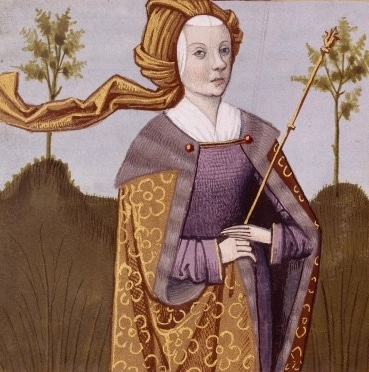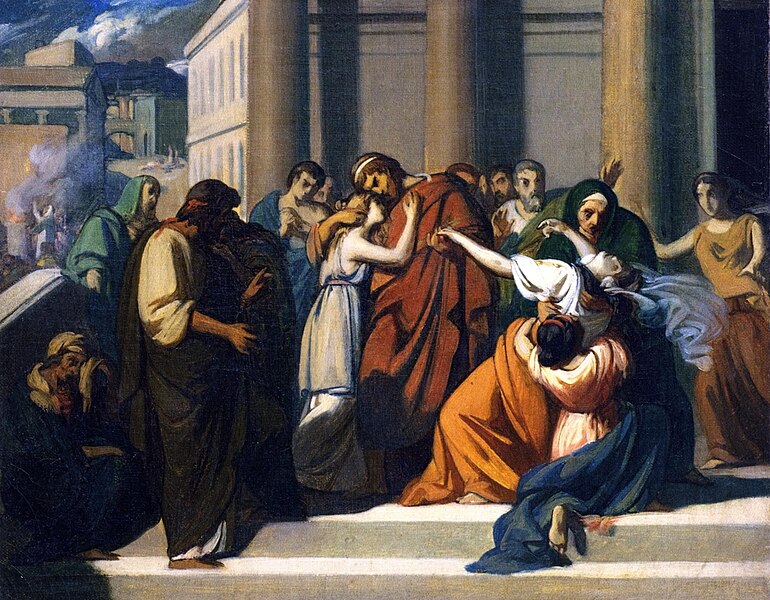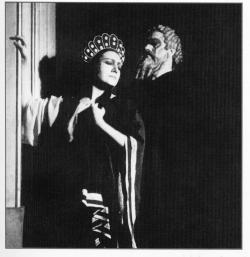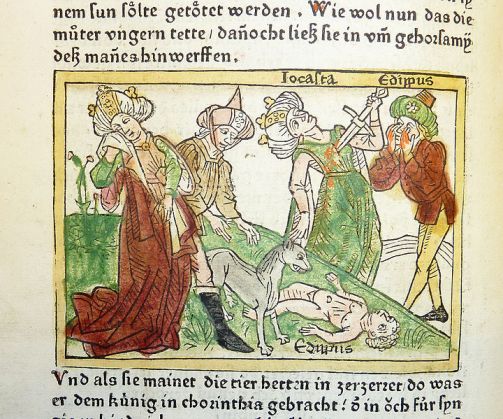In the vast tapestry of Greek mythology, certain figures stand out for their tragic destinies and the lessons they impart. One such figure is Queen Jocasta, a woman whose life was intertwined with prophecies, fate, and the inexorable will of the gods.
Jocasta Key Facts
| Parents | Menoeceus |
| Partners | Laius, Oedipus |
| Siblings | Creon |
| Offspring | Antigone, Ismene, Polynices, Eteocles |
| Other names | Iocaste |
| Roman name | Iocasta |
| Best Known Myth | Marriage to her son, Oedipus |
Name and Etymology

The name Jocasta, or “Iocaste” in some variations, is believed to have roots in ancient Greek, though its exact etymology remains a subject of debate. Some scholars suggest it might be derived from the Greek words for “violet” or “purple,” possibly indicating her royal status. In Roman myths, she retains her name as “Iocasta,” a testament to her significance and the universality of her tragic tale. Throughout various texts, she might be referred to by epithets or alternative names, but her story remains consistent, a poignant reminder of the dangers of attempting to defy fate.
Jocasta’s Family and Relationships
Jocasta was born into Theban royalty, the daughter of Menoeceus and the sister of Creon. Her early life, though not as extensively documented as her later years, was marked by the typical privileges and responsibilities of nobility. However, it was her marriage to King Laius that set the stage for the tragic events to follow. A prophecy foretold that Laius would be killed by his own son, leading him to abandon his newborn, Oedipus, to die. Fate, ever the trickster, ensured that Oedipus survived and later unknowingly killed Laius and married Jocasta, his own mother. This incestuous union produced four children: Antigone, Ismene, Polynices, and Eteocles.
Jocasta’s life was further complicated by the politics and conflicts of Thebes. Her brother, Creon, played pivotal roles in various myths, often clashing with Oedipus and later with Antigone. The intricate web of relationships and the weight of prophecy bore heavily on Jocasta, leading to her tragic end.
Myths about Jocasta
The myths surrounding Jocasta are a testament to the intricate and often tragic nature of Greek mythology. Her life, marked by prophecies, love, and despair, offers a profound exploration of human nature and the inexorable force of fate.
The Prophecy and Oedipus’ Abandonment
The oracle at Delphi, renowned for its cryptic yet unerring prophecies, foretold a grim fate for King Laius: he would meet his end at the hands of his own son. This prophecy cast a dark shadow over the birth of Oedipus. In a desperate bid to avert this tragic destiny, Laius and Jocasta made the heart-wrenching decision to abandon their newborn. They ordered a servant to leave the infant on the desolate slopes of Mount Cithaeron, his ankles cruelly bound, hoping to prevent the prophecy from coming to fruition.

However, fate is not so easily thwarted. A compassionate shepherd discovered the abandoned child and, moved by pity, handed him over to the childless King Polybus and Queen Merope of Corinth. They raised Oedipus as their own, shielding him from the truth of his origins.
Oedipus’ Return and the Unraveling of Truth
As Oedipus grew into a young man in Corinth, another prophecy would shape his destiny. Warned by the Delphic oracle that he was destined to kill his father and marry his mother, Oedipus, believing Polybus and Merope to be his true parents, fled Corinth to prevent this horrific fate. His journey led him to a fateful crossroads where he encountered a chariot driven by none other than his biological father, King Laius. Unaware of each other’s identities and following a heated altercation, Oedipus killed Laius, unwittingly fulfilling part of the prophecy.
Continuing his journey, Oedipus arrived in Thebes, which was under the shadow of the Sphinx, a monstrous creature posing riddles to passersby and devouring those who answered incorrectly. With his sharp intellect, Oedipus solved the riddle, freeing Thebes from the Sphinx’s terror. In gratitude, the Thebans offered him their vacant throne and the hand of the widowed queen, Jocasta. Neither Oedipus nor Jocasta realized their true relationship, and they were wed, setting the stage for the tragic revelation to come.
The Tragic Conclusion
The union of Oedipus and Jocasta bore four children: Antigone, Ismene, Polynices, and Eteocles. However, Thebes soon found itself plagued by famine and disease. Seeking answers, Oedipus consulted the oracle and was told that the city’s misfortunes were a result of Laius’ unresolved murder. Determined to find the murderer and save his city, Oedipus embarked on an investigation.
The truth unraveled bit by bit, with each revelation more horrifying than the last. When the full extent of their intertwined fates became clear – that Oedipus had killed his father and married his mother – the weight of this knowledge proved too much to bear. Jocasta, consumed by despair, took her own life, and Oedipus, in a fit of anguish, blinded himself.
Depiction And Characteristics
Jocasta is often depicted as a regal, mature woman, befitting her status as a queen. Symbols associated with her are less distinct than those of gods or more prominent heroes, but she is often shown in scenes with Oedipus, emphasizing their tragic relationship. In terms of personality, Jocasta is portrayed as loving, caring, and wise, but also as someone trapped by fate. Her attempts to protect her family, especially Oedipus, highlight her maternal instincts. Yet, her eventual despair showcases the weight of destiny and the gods’ will upon mortals.
Representations Of Jocasta In Art

Throughout history, Jocasta’s tragic tale has inspired countless artists. From ancient Greek vases depicting key moments of her story to Renaissance paintings showcasing her despair, her image serves as a powerful symbol of the consequences of defying fate. One notable artwork is “The Blind Oedipus Commending his Children to the Gods” by Bénigne Gagneraux, where Jocasta’s absence is palpable, emphasizing her tragic end and the void left in Oedipus’ life.
Mentions in Ancient Texts
The tale of Jocasta, like many figures from Greek mythology, is woven into the fabric of various ancient texts. These works, penned by some of the most illustrious authors of antiquity, offer unique perspectives on her story and the overarching themes of fate, tragedy, and human frailty.
“Oedipus Rex” by Sophocles
Sophocles, a renowned playwright from the 5th century BCE, is perhaps best known for his Theban plays, of which “Oedipus Rex” is a part. This tragedy delves deep into the life of Oedipus and his ill-fated relationship with Jocasta. A poignant quote from the play encapsulates the essence of their shared tragedy: “Alas, how terrible is wisdom when it brings no profit to the man that’s wise!”
“Phoenician Women” by Euripides
Euripides, another eminent playwright from the 5th century BCE, offers a different lens on the Theban saga in “Phoenician Women.” This play focuses on the aftermath of Jocasta’s death and the strife between her sons, Polynices and Eteocles. Euripides, known for his nuanced portrayal of female characters, paints Jocasta in a sympathetic light, emphasizing her victimhood in the face of overwhelming fate.
“The Library” by Apollodorus
Apollodorus, a scholar from the 2nd century BCE, compiled a vast array of Greek myths in his work “The Library.” This comprehensive text provides a more detached account of Jocasta’s life, offering a chronological overview of the events in Thebes. While it lacks the dramatic flair of the plays, it’s invaluable for its encyclopedic approach. A notable excerpt from this work states: “Driven by the curse of his father, Oedipus was led to commit grievous sins unknowingly.”
Frequently Asked Questions
Jocasta’s tragic flaw was her attempt to defy fate and protect her family from the prophecy, leading to unforeseen consequences.
No, Jocasta was unaware of their true relationship until the truth was later revealed.
Overwhelmed by the revelation of her marriage to her son, Jocasta took her own life.
Jocasta had four children with Oedipus: Antigone, Ismene, Polynices, and Eteocles.
While not directly involved, the events of Thebes and its royal family, including Jocasta, influenced other Greek myths, including those of Briseis, Menelaus, and Agamemnon.
Jocasta was primarily a victim of fate, but her actions, driven by love and fear, played a role in her tragic end.
Featured Image Credit: Alexandre Cabanel, Public domain, via Wikimedia Commons

